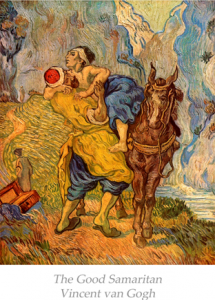(1)
On May 3, 2001, I was on the set of Minority Report. My friend Jim and I briefly talked with the director Steven Spielberg, about a special effect sequence. Once we were done discussing the scene, Jim and I moved off set. But we were still able to hear Spielberg talking to an underling next to him. Steven told him “You’ve got to hook them in the first few minutes.”
There’s Science to backup Spielberg here. Molecular biologist John Medina says in Brain Rules: “Audiences check out after 10 minutes, but you can keep grabbing them back by telling narratives or creating events rich in emotion.”2
10 minutes is probably around the time you start checking to see when class is over. Unless it’s an 8AM lecture. Then 5 minutes is acceptable. 😉
Well, now we know the secret to Spielberg’s success! But he’s not the only one who uses this brain rule.
Jesus used it, too.
In Matthew 7:28, it states: “And when Jesus finished these sayings, the crowds were astonished at his teaching,…” so He definitely kept people’s attention! Here’s some of the ways mentioned in the Bible:
- Explicitly saying ‘Pay attention’: Brings about desired effect on audience
- “He who has ears to hear, let him [and her] hear.”
- Translation: this stuff is important. Don’t fall asleep! (ok, that last part was me)
- Hyperbole: Brings a shock factor
- “If your right eye causes you to sin, tear it out and throw it away. For it is better that you lose one of your members than that your whole body be thrown into hell.” Matthew 5:29
Guessing that verse got your attention!
- Provocative Questions: Causes people to stop and listen
- For what will it profit a man if he gains the whole world and forfeits his soul?” Matthew 16:26
- Parables:
(3)
Going to go more in-depth on parables here. They’re not always very long. Some of them are only a few verses (if only assigned college textbook readings were that short!). But they captured the audience’s attention, because Jesus used contexts and objects they understood. Even now, when the context is a bit lost to us, we still pay attention. When I read one of Jesus’ parables, I’m hooked. There’s a riddle and I’ve got to solve it. There’s a treasure in the answer.
By allowing these stories from our Lord to capture my attention, I learn about the Kingdom of God, and the character of God.
I also learn what God expects of me.
The first step in becoming more Christ-like: enable to Holy Spirit to work in us.
But we need to give Him something to work with. That something is to allow Scripture to get our attention.
(4)
Look at M.C. Escher. Escher was able to find treasure in a simple piece of moss! As a young artist, Escher wrote in a letter to Jan van der Does de Willebois: “I want to delight in the smallest of small things, a bit of moss 2 cm in diameter on a little piece of rock, and I want to try here what I have been wishing for so long, namely to copy these tiniest bits of nothing as accurately as possible just to realize how great they are. I’ve already started that but it is so dreadfully difficult. With your nose right on top of it, you see all of its beauty and all of its simplicity, but when you start drawing, only then do you realize how terribly complicated and shapeless that beauty really is.”5 That’s it. Things that others passed by, captured Escher’s attention. He tried to draw them. It was difficult for him, but in pressing forward he grew and gained a deeper appreciation of the subject matter. At the same time, he also matured and transformed as an artist. If Escher can find value and morph because of a little piece of moss, we can do that with parables!
We are what we pay attention to.
If we focus to worldly aspects of culture, we morph more towards that culture.
If we focus to Scripture, we renew our minds and morph into Christ-like beings.
Choose to pay attention to Scripture. Spend some quality time with God. The Holy Spirit within you will resonate as you read God’s Word. That will enable you to grow.
Sources:
- Steven Spielberg, Photo by Georges Biard. This file is licensed under the Creative Commons Attribution-Share Alike 3.0 Unported license. Retrieved from Wikipedia.com on January 15, 2016.
- Note: this image is currently not being used on the English version of Wikipedia’s Stephen Spielberg page. However it is still being used on the Lithuanian version of the page, as seen here.
- Medina, John J. 2008, Brain rules, 12 Principles for Surviving and Thriving at Work, Home, and School, Page 94. Seattle, Washington: Pear Press.
- The Good Samaritan, Vincent van Gogh. Public Doman. Retrieved from wikiart.org on January 19, 2015.
- Study for Waterfall, M. C. Escher. Retrieved from pintrest.com/jose3542 on Feb. 16, 2016
- Locker, J. L. 2000, The Magic of M. C. Escher, Page 115. New York, New York: Harry N. Abrams, Inc., Publishers.



